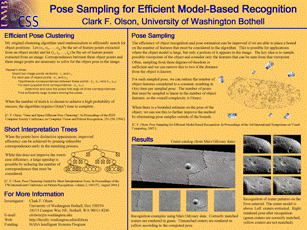|
|

|
Pose estimation by recognizing crater patterns
Investigators:
Clark F. Olson (PI), University of Washington, Bothell
Yang Cheng, Jet Propulsion Laboratory
Summary:
Real-time position estimation for a descent lander is a critical technological need for many planned NASA missions. For example, the capability to land precisely and safely in a scientifically promising but hazardous site is a key technology to be demonstrated by NASA in the next decade. Currently, onboard spacecraft position estimation methods are either too slow or too inaccurate. In this project, we will develop an optical (i.e. image based) position estimation method using surface landmarks that enables pinpoint landing on cratered and hazardous terrain. Initially, the landmarks will consist of craters (abundant on Mars, the Moon, Mercury and many other bodies).
A poster describing this work can be seen by clicking on the icon.
 . .
Related publications:
Clark F. Olson.
Pose Sampling for Efficient Model-Based Recognition.
In Advances in Visual Computing, Lecture Notes in Computer Science, Vol. 4841 (Third International Symposium on Visual Computing),
pages 781-790, Nov. 2007.
Abstract ,
Download (2069 K)
Clark F. Olson.
Pose Clustering Guided by Short Interpretation Trees.
In Proceedings of the 17th International Conference on Pattern Recognition,
volume 2, pages 149-152, August 2004.
Abstract ,
Download (292 K)
Yang Cheng, Andrew E. Johnson, Larry H. Matthies, and
Clark F. Olson.
Optical Landmark Detection for Spacecraft Navigation.
In Proceedings of the 13th AAS/AIAA Space Flight Mechanics Meeting,
Ponce, Puerto Rico, February 2003.
Abstract
Clark F. Olson,
A General Method for Geometric Feature Matching and Model Extraction,
International Journal of Computer Vision, 45(1): 39-54, October 2001.
Abstract ,
Download (560 K)
Clark F. Olson,
Efficient Pose Clustering Using a Randomized Algorithm,
International Journal of Computer Vision, 23(2):131-147,
June 1997.
Abstract ,
Download (781 K)
|